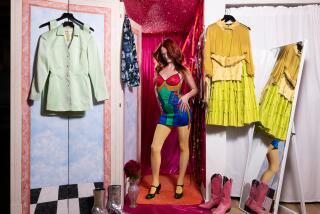Throwing Design a Curve
- Share via
At Denmark’s award-winning Bang & Olufsen, which has been in business since 1925, design drives the company. “We have had the same philosophy for the last 50 years,” says Ole Bek, president of Bang & Olufsen, America. “The designer is totally in charge once the basic idea, often just a cardboard model, is approved. After that there’s no management input at all. That takes a little courage from time to time, but it’s the way we do things.”
Design innovations continue today with all-in-one systems like BeoLink, which allows for all the video and audio components in a home to be connected and controlled by one single, sleek remote called the Beo 4, which company officials claim is so simple it can be operated in the dark. “By pushing one button on this one remote, you can do 13 different functions that would normally need three remotes,” says Fernando Alfaro, product specialist at South Coast Plaza’s B&O.; This follows their idea of simplifying both design and technology for easy mastery.
“Our products have to be the best because we charge for it,” says Bek. “If we can’t do something unique, we just won’t do anything.”
Some critics say that B&O; waits too long to put some products on the market, like the commercially available flat-screened plasma television, which has been available from other companies for about four years. B&O; just introduced one in December, with its high-definition compatible plasma television retailing for about $10,000. “We were waiting to come out with a plasma TV until we could get the technology we wanted,” says Bek. Plasma TVs in different brands now run as low as $4,000 for one with a 42-inch screen at discount stores.
In the home theater showroom of the B&O; stores, the thin TV hangs on the wall with the two small color-coordinated speakers below it. Additional speakers, which can be hooked to the TV and stereo system, are tall, standing cylinders available in black, blue, green, red or aluminum. “Our designers came to us with a pencil, and said they wanted that to be the shape of the speakers. There was no available technology to have the speakers in that shape, so it took us two years to develop them.”
Their most successful product to date is the BeoSound 9000, retailing for about $4,000, which has a radio with six CDs on display. The spinning CD that is playing creates a colorful moving design. The unit can be put on a table or hung vertically or horizontally on the wall. BeoSound 1, a portable, built-in CD/radio with powerful speakers, is also popular for its organic, curved shape and is available in five colors with all the controls hidden in back.
The emphasis on design has worked well for the company most of the time. Bek could only name one product, a television available only in Europe, that was a great design that nobody bought. “We loved it, but it didn’t sell, so we took it off the market.”
Peter Fiell, author of “Scandinavian Design,” due out from Taschen publishing in September, says, “For me, one of the high points of design at B&O; happened in the 1960s and 1970s, with Jacob Jensen’s audio systems. With these, Jensen completely redefined the design vocabulary of audio equipment and gave the company its unmistakable identity. You can still very clearly see this language of design in B&O;’s products today.” In 1978, New York’s Museum of Modern Art, which has 21 B&O; products in its permanent design collection, presented a special Bang & Olufsen exhibition.
Another reason for the continuity of their design look is the small turnover in designers. “David Lewis has been with us for 25 years,” says Bek. “He works with a group of around 60 people, designers, mechanics, engineers, in what we call ‘Idealand.’ Sometimes the company sees the need for a new product and sometimes the Idealand people bring a new concept to us.”
According to Fiell, David Lewis’ BeoSystem 2500 in 1990 marked another high point at B&O.; “His all-in-one layout was revolutionary and was critical in differentiating B&O;’s products within the marketplace,” he says. In the design of this system, Lewis emphasized function with the flat front of the CD and tape recorder protected by a shade that slides open when in use. In 1990, the company was awarded ID Magazine’s Classics Prize, the first time the award was given to a company rather than a product.
“Our single golden rule is that if a product doesn’t bring a smile to your face the first time you see it, we won’t create it.” Certainly the glass curtains that open and close on the plasma TV, the curved telephone for $475 that fits in its triangular stand or snugly in the hand and the lights that dim or brighten at the touch of the remote do just that.
“To me,” concludes Fiell, “B&O; epitomizes the attributes of good design: durability, unity, integrity and inevitability.” Bang & Olufsen has stores throughout the United States. For more information, visit the Web site at www.bang-olufsen.com.


